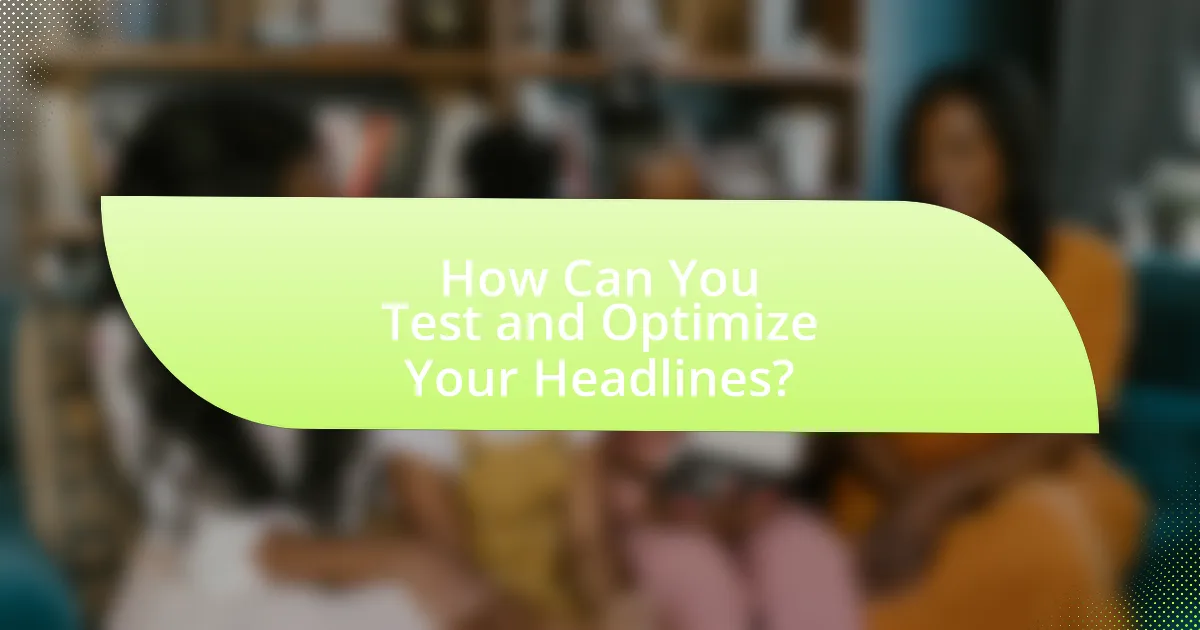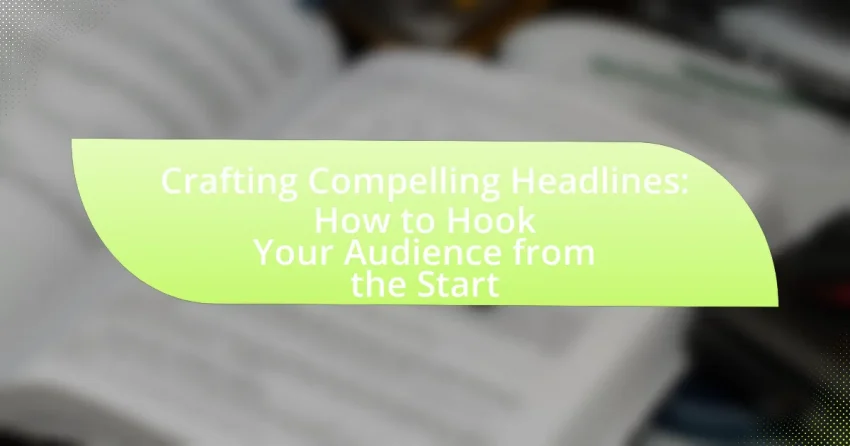The article focuses on the essential elements of crafting compelling headlines that effectively engage audiences. It outlines key strategies such as clarity, emotional appeal, specificity, and the use of psychological triggers like curiosity and urgency. The article also discusses the importance of headline structure, word choice, and length, emphasizing how these factors influence reader engagement and click-through rates. Additionally, it provides techniques for optimizing headlines through A/B testing and highlights best practices to avoid common pitfalls in headline writing. Overall, the content serves as a comprehensive guide for creating impactful headlines that attract and retain reader interest.

What Makes a Headline Compelling?
A compelling headline grabs attention and encourages readers to engage with the content. Key elements that contribute to this effectiveness include clarity, emotional appeal, and specificity. For instance, headlines that evoke curiosity or urgency, such as “Unlock the Secrets to Financial Freedom Today,” tend to perform better. Research indicates that headlines with numbers or lists, like “5 Tips for Effective Time Management,” can increase click-through rates by up to 36%. Additionally, using strong action verbs and addressing the reader directly can enhance relatability and interest. These strategies collectively ensure that a headline stands out in a crowded information landscape.
How do headlines influence audience engagement?
Headlines significantly influence audience engagement by capturing attention and conveying the essence of the content. Research indicates that 80% of people read headlines, while only 20% proceed to read the full article, demonstrating the critical role headlines play in attracting readers. Effective headlines utilize emotional triggers, curiosity, and clarity to entice the audience, leading to higher click-through rates and increased interaction with the content. For instance, a study by CoSchedule found that headlines with numbers and strong adjectives can boost engagement by up to 73%. Thus, well-crafted headlines are essential for maximizing audience engagement.
What psychological triggers do effective headlines use?
Effective headlines utilize psychological triggers such as curiosity, urgency, and social proof to engage readers. Curiosity is sparked by posing intriguing questions or presenting unexpected information, compelling readers to seek answers. Urgency creates a sense of immediacy, often through time-sensitive language, motivating readers to act quickly. Social proof leverages the influence of others, suggesting that popular or widely accepted ideas are more credible, which can enhance trust and interest. Research by Nielsen Norman Group indicates that headlines with these triggers significantly increase click-through rates, demonstrating their effectiveness in capturing audience attention.
How does the choice of words impact headline effectiveness?
The choice of words significantly impacts headline effectiveness by influencing reader engagement and comprehension. Specific, action-oriented words tend to attract more attention and evoke emotional responses, which can lead to higher click-through rates. For instance, a study by BuzzSumo found that headlines with strong adjectives and verbs generated 63% more shares on social media compared to those with weaker language. This demonstrates that precise word selection not only captures interest but also enhances the overall effectiveness of the headline in conveying the intended message.
Why is the structure of a headline important?
The structure of a headline is important because it directly influences reader engagement and comprehension. A well-structured headline captures attention, conveys the main idea succinctly, and encourages further reading. Research indicates that headlines with clear, concise language and a strong emotional appeal can increase click-through rates by up to 300%. This demonstrates that effective headline structure not only attracts readers but also enhances the likelihood of content consumption.
What are the key components of a strong headline?
A strong headline consists of clarity, relevance, and emotional appeal. Clarity ensures that the message is easily understood, allowing readers to grasp the content’s essence quickly. Relevance connects the headline to the audience’s interests or needs, making it more likely to attract attention. Emotional appeal engages readers by evoking feelings or curiosity, prompting them to read further. Research indicates that headlines with these components can increase click-through rates significantly, with studies showing that emotionally charged headlines can boost engagement by up to 30%.
How does length affect the performance of a headline?
Length significantly affects the performance of a headline by influencing reader engagement and comprehension. Research indicates that headlines with 6 to 10 words tend to generate higher click-through rates, as they are concise yet informative, allowing readers to quickly grasp the content’s essence. For instance, a study by CoSchedule found that headlines with 8 words receive 21% more engagement than longer or shorter alternatives. This demonstrates that optimal headline length can enhance visibility and attract more readers, ultimately improving content performance.

What Techniques Can Be Used to Craft Compelling Headlines?
Techniques to craft compelling headlines include using numbers, asking questions, employing strong adjectives, and creating a sense of urgency. For instance, headlines with numbers, such as “5 Tips for Effective Time Management,” attract attention due to their specificity and promise of actionable content. Questions engage readers by prompting them to seek answers, as seen in “Are You Making These Common Mistakes in Your Writing?” Strong adjectives enhance emotional appeal, exemplified by “Unforgettable Travel Destinations You Must Visit.” Lastly, urgency can be created with phrases like “Limited Time Offer,” encouraging immediate action. These techniques are supported by research indicating that headlines with numbers and questions significantly increase click-through rates, demonstrating their effectiveness in capturing audience interest.
How can emotional appeal enhance a headline?
Emotional appeal can enhance a headline by making it more relatable and engaging to the audience. When a headline evokes emotions such as joy, fear, or curiosity, it captures attention and encourages readers to click or read further. Research indicates that headlines with emotional triggers can increase click-through rates by up to 30%, demonstrating their effectiveness in attracting interest. By tapping into the audience’s feelings, a headline can create a stronger connection, leading to higher engagement and retention of the content.
What emotions should be targeted in headlines?
Headlines should target emotions such as curiosity, fear, joy, surprise, and trust. Curiosity drives readers to seek more information, while fear can create urgency and prompt action. Joy evokes positive feelings, making content more appealing, and surprise captures attention effectively. Trust is essential for credibility, encouraging readers to engage with the content. Research indicates that headlines eliciting these emotions can significantly increase click-through rates, as demonstrated by a study from BuzzSumo, which found that emotionally charged headlines outperform neutral ones in engagement metrics.
How can storytelling be incorporated into headlines?
Storytelling can be incorporated into headlines by using narrative elements that evoke curiosity and emotion. For instance, headlines can present a character, a conflict, or a resolution, which engages readers by hinting at a larger story. Research indicates that headlines with storytelling elements can increase click-through rates by up to 300%, as they create a connection with the audience and encourage them to explore further. By framing headlines as questions or using vivid imagery, writers can effectively draw readers into the narrative, making the content more relatable and compelling.
What role does specificity play in headline creation?
Specificity in headline creation enhances clarity and engagement by providing precise information that attracts the target audience. Specific headlines convey exact details, such as numbers, locations, or unique attributes, which help readers quickly understand the content’s value. For instance, a headline like “10 Proven Strategies to Boost Your Website Traffic by 50%” is more compelling than a vague statement like “Improve Your Website.” This specificity not only captures attention but also sets clear expectations, increasing the likelihood of clicks and shares. Research indicates that headlines with specific numbers can increase engagement rates by up to 73%, demonstrating the effectiveness of specificity in driving reader interest.
How can numbers and statistics improve headline appeal?
Numbers and statistics enhance headline appeal by providing concrete evidence that captures attention and establishes credibility. Headlines featuring specific figures, such as “7 Tips for Better Sleep” or “50% Off All Items,” create a sense of urgency and clarity, making the content more enticing. Research indicates that headlines with numbers can increase click-through rates by up to 36% compared to those without, demonstrating their effectiveness in engaging readers. This quantifiable approach not only piques interest but also sets clear expectations for the content, thereby improving overall reader engagement.
What examples illustrate the power of specific headlines?
Specific headlines can significantly impact engagement and conversion rates. For instance, the headline “You Won’t Believe What Happened Next” generated a 500% increase in click-through rates for a BuzzFeed article, demonstrating the effectiveness of curiosity-driven headlines. Another example is the New York Times’ “How to Lose Weight Without Dieting,” which attracted a large readership by addressing a common desire with a straightforward promise. These examples illustrate that specific, compelling headlines can capture attention and drive audience interaction effectively.

How Can You Test and Optimize Your Headlines?
To test and optimize your headlines, utilize A/B testing to compare different versions and analyze performance metrics such as click-through rates and engagement levels. A/B testing allows you to present two variations of a headline to different segments of your audience, enabling you to identify which one resonates more effectively. According to a study by HubSpot, A/B testing can increase conversion rates by up to 49%, demonstrating its effectiveness in headline optimization. Additionally, tools like Google Optimize and Optimizely can facilitate this process by providing insights into user behavior and preferences, further enhancing your ability to craft compelling headlines.
What methods are available for testing headline effectiveness?
A/B testing is a primary method for testing headline effectiveness, where two or more headline variations are compared to determine which performs better in terms of engagement metrics such as click-through rates. This method allows marketers to gather quantitative data on audience preferences, enabling them to make informed decisions based on actual user behavior. Additionally, tools like Google Optimize and Optimizely facilitate A/B testing by providing platforms for easy implementation and analysis of results. Research indicates that A/B testing can lead to significant improvements in conversion rates, with some studies showing increases of up to 49% when effective headlines are used.
How can A/B testing be implemented for headlines?
A/B testing for headlines can be implemented by creating two variations of a headline and measuring their performance against a specific metric, such as click-through rate or conversion rate. To execute this, first, select a target audience and divide it into two groups. Each group is then exposed to one of the headline variations. After a predetermined period, analyze the data to determine which headline performed better based on the chosen metric. This method is supported by research indicating that A/B testing can lead to significant improvements in engagement, with studies showing that even small changes in headlines can result in up to a 30% increase in click-through rates.
What metrics should be analyzed to evaluate headline performance?
To evaluate headline performance, key metrics include click-through rate (CTR), engagement rate, bounce rate, and social shares. Click-through rate measures the percentage of users who click on the headline compared to the total number of impressions, indicating its effectiveness in attracting attention. Engagement rate assesses how users interact with the content after clicking, reflecting the headline’s ability to resonate with the audience. Bounce rate indicates the percentage of visitors who leave the page without further interaction, providing insight into the headline’s relevance. Social shares quantify how often the headline is shared across social media platforms, showcasing its appeal and reach. Analyzing these metrics collectively offers a comprehensive view of a headline’s performance and effectiveness in capturing audience interest.
How can feedback improve headline crafting?
Feedback can significantly enhance headline crafting by providing insights into audience preferences and engagement levels. When writers receive feedback, they can identify which headlines resonate most with readers, allowing them to refine their language, tone, and structure. For instance, A/B testing different headlines and analyzing click-through rates can reveal specific wording or emotional triggers that attract more attention. This data-driven approach ensures that headlines are not only creative but also effective in capturing audience interest, ultimately leading to higher engagement and conversion rates.
What sources of feedback are most valuable for headline optimization?
The most valuable sources of feedback for headline optimization include A/B testing results, audience surveys, and analytics data. A/B testing allows marketers to compare different headlines and determine which one performs better in terms of click-through rates. Audience surveys provide direct insights from target demographics about their preferences and perceptions of headlines. Analytics data, such as engagement metrics and conversion rates, offers quantitative evidence on how well headlines resonate with the audience. These methods collectively enhance the effectiveness of headlines by grounding decisions in empirical evidence and user preferences.
How can audience insights shape future headline strategies?
Audience insights can significantly shape future headline strategies by providing data on what resonates with target demographics. By analyzing metrics such as click-through rates, engagement levels, and audience preferences, marketers can tailor headlines to align with the interests and behaviors of their audience. For instance, a study by BuzzSumo found that headlines with specific emotional triggers, such as curiosity or urgency, generated 63% more shares than neutral headlines. This demonstrates that leveraging audience insights allows for the creation of more compelling and effective headlines that drive engagement and improve content performance.
What are some best practices for crafting headlines?
Best practices for crafting headlines include using clear and concise language, incorporating strong keywords, and evoking curiosity or emotion. Clear language ensures that the message is easily understood, while strong keywords improve search engine optimization, making the content more discoverable. For instance, headlines with actionable verbs can increase engagement; research shows that headlines with numbers, such as “5 Tips for Effective Writing,” tend to perform better in attracting clicks. Additionally, using questions or intriguing statements can pique interest, leading to higher reader engagement.
How can you ensure clarity and conciseness in your headlines?
To ensure clarity and conciseness in your headlines, use straightforward language and limit word count. Clear headlines typically contain fewer than 10 words, focusing on the main idea without unnecessary jargon. Research indicates that headlines with 6 to 8 words perform best in capturing reader attention, as they are easier to process and remember. Additionally, employing active voice and specific terms enhances understanding, making the headline more impactful.
What common mistakes should be avoided when writing headlines?
Common mistakes to avoid when writing headlines include using vague language, failing to convey value, and neglecting to consider the target audience. Vague language can lead to confusion, as headlines should be clear and specific to attract readers. For instance, a headline like “Improve Your Life” lacks specificity compared to “5 Simple Steps to Boost Your Productivity.” Additionally, headlines must convey value; if readers do not see a benefit, they are less likely to engage. Lastly, understanding the target audience is crucial; headlines that do not resonate with the intended demographic will fail to capture attention. Research indicates that headlines tailored to audience interests can increase click-through rates significantly, demonstrating the importance of these considerations in effective headline writing.
